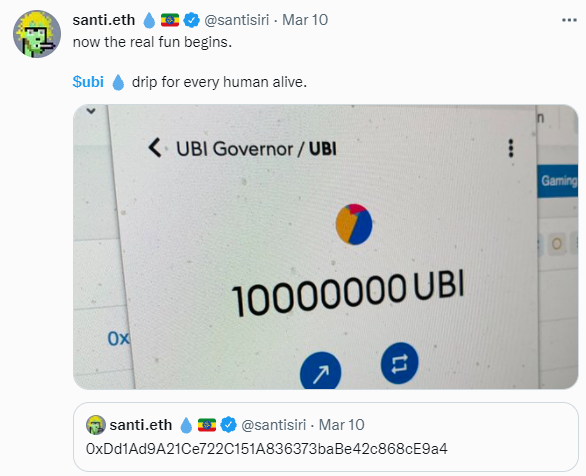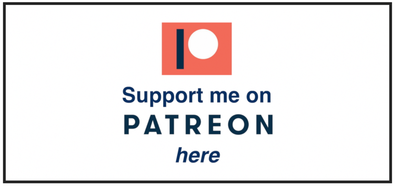Proof of Humanity and the Universal Basic Income Coin

On March 10, 2021, Proof of Humanity’s UBI coin went live on the Ethereum Mainnet. For anyone who doesn’t know what that sentence means, it means that a cryptocurrency project was launched using the most popular smart contract blockchain in the world, with the goal of eventually providing a basic income to every living human being. In this post, I’ll explain what it is, how it works, how to start receiving it, why it’s Vitalik Buterin approved, and how to help the project grow and succeed in its goal of eventually providing a global unconditional basic income floor.
How $UBI Works
Here’s how it works: Humans who have been verified as being real, begin to receive basic income at a rate of 1 UBI coin per hour. It’s actually streamed at a constant rate, so every few seconds, all recipients get a tiny bit more. Every day, that’s 24 UBI coins. Every week, that’s 168 UBI coins. Every 30 days, that’s 720 UBI coins. Every year, that’s 8,760 UBI coins. The price of each coin depends on what it’s trading at, but if the price happens to be $0.12 which it is as I write this according to CoinMarketCap, that translates to $2.88/day, $20.16/week, $86.40/month, and $1,051/year in USD. If you live in a place like the EU or US, that amount can be helpful, but if you live in a place like Kenya or Uganda, that amount can be nothing short of life-changing.
The UBI coins ($UBI) that are streamed to recipients are all newly minted money out of nothing using the Ethereum blockchain. (For anyone concerned about energy consumption, Ethereum is expected to soon use 33,000 times less energy per transaction than Bitcoin with its transition from proof-of-work to proof-of-stake). The value of the currency is determined by exchanges like Uniswap, where people are able to trade other currencies for UBI. Uniswap is a decentralized exchange that UBI was launched on that utilizes something called liquidity pools (LP), which are currency pairs that people have contributed to. By adding a pair of cryptocurrencies to an LP, those who fill the pools are able to earn a percentage of the revenue from exchanges, and those who want to exchange one currency for another are able to peer-to-peer. In the crypto world, this is part of the decentralized finance (or DeFi) revolution that is empowering everyday people over traditional financial service providers.
There are two primary pools for $UBI on Uniswap, an ETH-UBI pair (v2/v3) and a DAI-UBI pair (v2/v3). Let’s say you want to add liquidity to the ETH-UBI pool. You could add say $1,000 worth of Ether and $1,000 worth of $UBI. If someone than traded some ETH for $UBI, the price of $UBI would go up in relation to ETH, and you would get a percentage of the fee applied to the trade by Uniswap.
Besides the incentive provided by getting a share of the trading fees, there’s an additional incentive provided by Proof of Humanity via what’s called liquidity pool mining, where you have the option of staking the ETH-UBI or DAI-UBI tokens you get from adding liquidity to either pool, to obtain $UBI as interest. As I write this, the APR for LP mining $UBI is 66% for the ETH pool and 73% for the DAI pool (DAI is a stablecoin pegged to USD where 1 DAI is 1 USD).
There is of course risk involved in adding liquidity and/or LP mining. When you add a liquidity pair, you won’t get the exact same ratio back when you withdraw your liquidity. If one half of the pair decreases in value quite a bit compared to the other, you’ll get more of that back and less of the other. Over time, what’s referred to as “impermanent loss” can mean getting back less than you put in. It’s also possible that the USD value of what you deposited goes down, and the value of $UBI itself goes down, so it’s possible to expect a 70% interest rate that actually ends up being a negative 1000% interest rate from devaluation. Of course, the opposite can also be true, where if both parts of the pair go up in value, it can mean a lot larger return than 70%. It could be a 1000% return or more. As the saying goes, buyer beware. Cryptocurrency is highly volatile.
Despite the volatility of cryptocurrencies like $UBI though, it does have actual value, and does provide recipients with the ability of converting it into a more widely used cryptocurrency that can then be converted into whatever someone's local currency may be. There are a couple extra steps involved compared to UBI provided in fiat itself though, but by using something like Coinbase for example, it’s possible for someone in the US to trade their $UBI for USDC (a stablecoin pegged to USD) on Uniswap, then send their USDC to their account on Coinbase, and then either sell their USDC for USD to then withdraw to their bank account, or if they have a Coinbase debit card, use their USDC just like they would money from a standard bank account. Because of this ability to exchange $UBI for most any fiat currency, it still qualifies as basic income for the same reason receiving UBI in Canadian currency while living in America would still be considered basic income despite the need to convert it first to use it.
_large.jpg)
How to Get $UBI
So now that you have a basic understanding of how $UBI has actual market value, how do you get it? You need to go through the Proof of Humanity verification process to prove proof-of-uniqueness.
First, you’re going to need an Ethereum wallet like Metamask, and you’re going to need at least 0.14 ETH in it (about $588 with ETH currently at $4,200). There also is an option to crowdfund your deposit if you don't have the necessary ETH.
Next, you’re going to need to connect your wallet to the Proof of Humanity app, and fill out the application with your name, short bio, a photo of your face, and a short video of you holding up your ETH address while saying that you are a unique human not already registered in the registry.
Submitting the application requires a refundable deposit of 0.128 ETH and an additional fee to execute the smart contract itself which varies depending on gas prices, but will likely be at least an additional 0.01 ETH. The point of the deposit is two-fold. First, the potential of losing it is meant to deter people from trying to cheat the system by setting up multiple accounts. Second, the deposit is used as an incentive for people to challenge applications. If someone challenges your application and they win in the Kleros court, you will lose your deposit, and they will get it (plus the jurors who voted against you will get some of it too).
Side note: I’m actually learning more about this process personally as I write this, because my renewal application has been challenged by someone seeking my deposit. If you’re curious about how the court system works, here’s an intro, and if you want to avoid it, follow the application instructions to the letter.
Once your application has been submitted, you will need to be vouched for as real by someone who has already been verified. Vouchers are only supposed to vouch for people they know for certain are real, so you’ll need to ask someone you know, or join a Zoom meetup intended to get people verified.
Once you have been vouched for, and your application has not been challenged by anyone, then after a few days, your deposit will be returned to you, and you will be verified and begin receiving a constant stream of $UBI. This stream will continue for one year, at which point you will need to go through the entire process again (except for needing a voucher). At least, that’s true as of right now. It seems likely the renewal process will see further improvements as PoH scales. Since launch, it’s already been changed from expiring every six months to expiring every year.
How to Help $UBI Grow
Now that you know what $UBI is and how you can start receiving it, you may be wondering what you can do to get involved in the community and how to help improve the way everything works and the value of $UBI. Here are some resources for you:
You can participate in the Proof of Humanity forum to interact with the community. Discuss ways to improve Proof of Humanity and $UBI. Learn about and even propose things to vote on to participate in the management of the DAOs.
The Tokenomics of $UBI is where a lot of ideas are needed. A big challenge that needs to be overcome is how to maintain and even grow the value of an inflationary currency. So far, a few options have been implemented, and more are being considered and developed all the time. Among the biggest recent projects implemented have been the Yearn vaults.
There are two Yearn vaults so far: a UBI-DAI vault and a UBI-WETH vault. The vaults allow people to deposit their DAI or their Ether (wrapped) to earn interest over time. When someone withdraws their deposit from the vault, half of their accumulated interest goes to them, and the other half goes to buy and burn $UBI to reduce the supply to raise the price. The Ether vault actually just reached its capacity of 400 ETH, so as of right now, only DAI can be deposited, and BTC will be the next vault to be opened.
For an ongoing list of other projects as they are developed, keep an eye on Humanity Tools (one tool I find particularly useful personally is the UBI farming calculator), and Proof of Humanity’s Twitter feed and Telegram channel.
Vitalik Buterin's Support of $UBI
If you’ve come this far in both finding this post and reading all the way to here, there’s a good possibility you know who Vitalik Buterin is, but if you don’t, he’s the founder of Ethereum, and he knows that one of the big long-term challenges is proof of uniqueness. A project that can solve that problem in the crypto world is extremely useful. He’s also very interested in the ability of crypto to combat global poverty, so Proof of Humanity and $UBI got onto his radar.
In July 2021, he went through the verification process to become a verified human, and in October 2021, he bought 50 ETH worth of $UBI (about $200,000) and immediately burned it to reduce the overall supply by almost 10%. The result of Vitalik’s buy and burn in combination with his official stamp of approval of the project resulted in the price of $UBI skyrocketing from $0.04 to over $2. Since then the price seems to have settled at a new equilibrium of around $0.12, but with the coin suddenly now on a lot more radars, the future of the project seems a lot brighter, especially in comparison to shiny metal orbs looking to scan the eyeballs of developing nation populations as a centralized Silicon Valley solution to the proof of uniqueness problem.
If you’d like to learn more about PoH's $UBI, below is a talk given by its founder, Santiago Siri in July 2021. And, if you do sign up to start receiving $UBI, besides hodling it, one of the things you can do with it to help support UBI in general would be to trade it for something like ETH or DAI and then donate it to Humanity Forward to help get a permanent national UBI passed in the US.
Think people with UBI will stop working or that it will lead to inflation? Here's a list of answers to those and other frequently asked questions.

Like my work? Please subscribe to my News Flash and also consider making a small monthly pledge in support of my daily work in advocacy of UBI. You can also book some time to chat with me on Zoom if you have questions about UBI you'd like to ask me directly.
Interested in reading a book about basic income? Here's a BIG list.
Follow me: Twitter | Facebook | YouTube | Apple Podcasts | Spotify | Reddit
UBI Guide Newsletter
Join the newsletter to receive the latest updates in your inbox.
